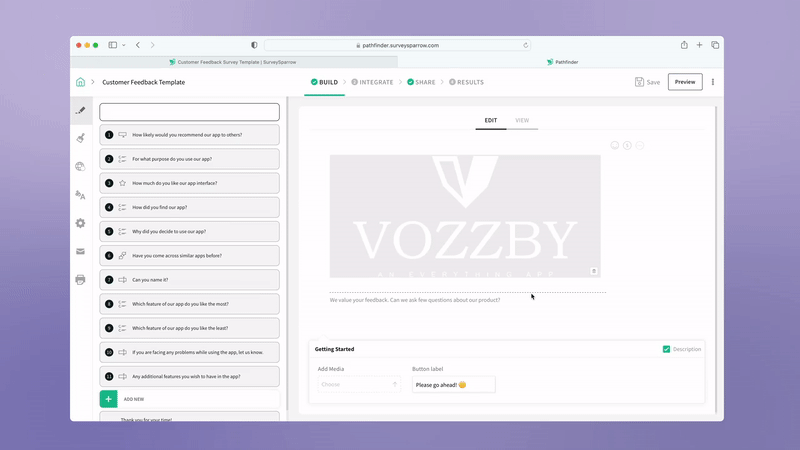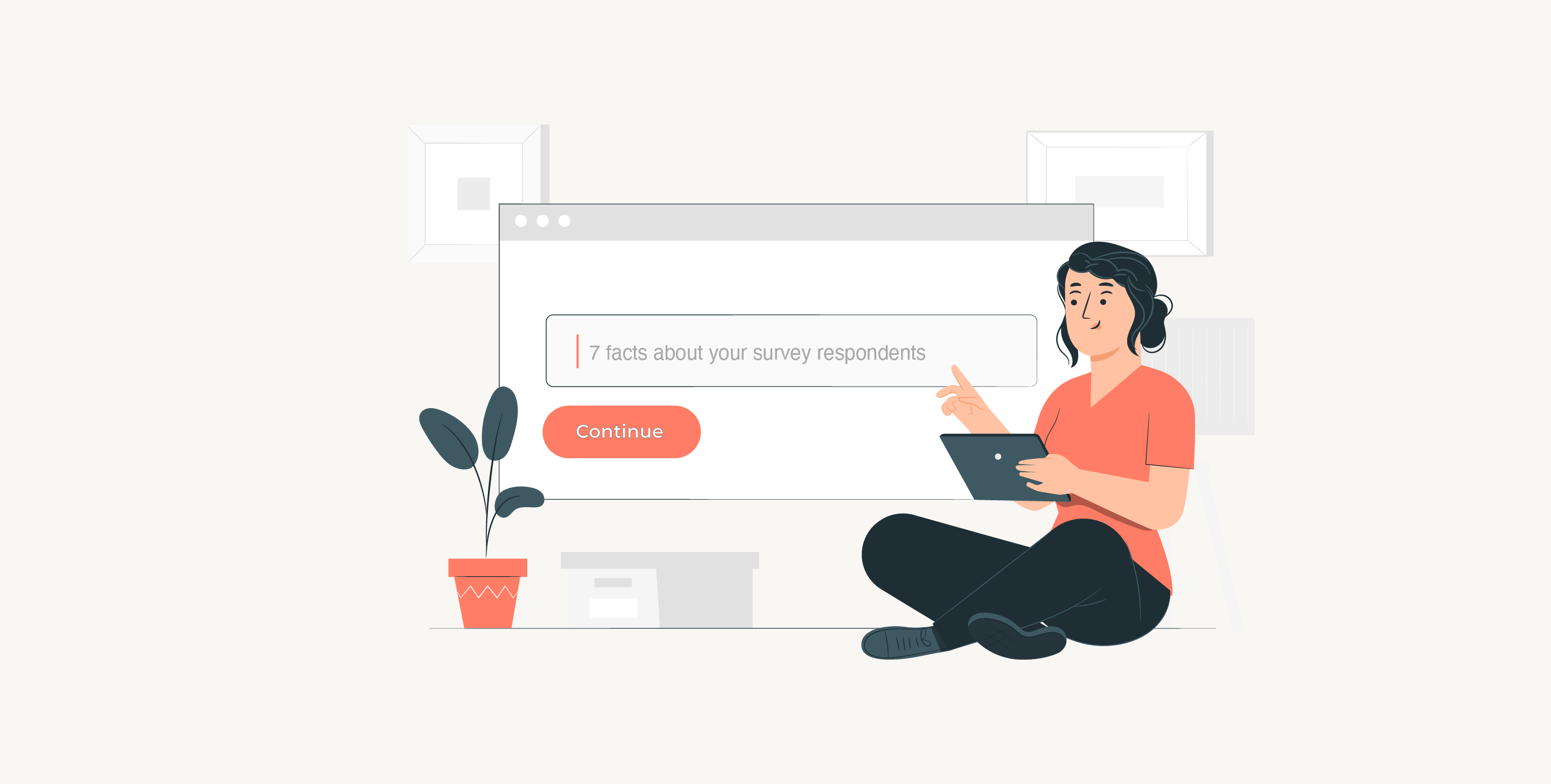Survey & Feedback
50+ Best Demographic Survey Questions (Free Template Included)
Article written by Parvathi Vijayamohan
Content marketer at SurveySparrow.
16 min read
19 September 2025

1-Minute Summary
Demographic surveys collect information about respondents' backgrounds, such as age, gender, income, education, and location, aiding in audience segmentation and personalized marketing strategies.
Key Demographic Categories
- Age: Understanding generational differences to tailor products and services.
- Gender: Recognizing gender-specific preferences and needs.
- Ethnicity & Race: Appreciating cultural backgrounds for inclusive practices.
- Income: Assessing purchasing power and economic status.
- Location: Identifying regional trends and preferences.
- Education Level: Determining educational backgrounds for targeted communication.
- Employment Status: Understanding occupational demographics.
Best Practices
- Use inclusive and respectful language.
- Provide "Prefer not to say" options to respect privacy.
- Ensure questions are relevant to the survey's purpose.
Tools Provided: A free, customizable demographic survey template is available to streamline the data collection process.
There are more than 8 billion individuals on earth. According to a study released by the US Commerce Department in January 2024, there will be approximately 4.3 births every second! That’s a lot of people, and each one’s interests and opinions count!
This is why crafting the perfect set of Demographic Survey Questions matters.
Confused? Don’t worry. I’ll include sample questions and a bit about how to use them, the question types to focus on, their benefits, and a few best practices to follow while creating them.
(Psst…A free demographic survey template has been added so you can easily understand the process!)
Oh! If you want to jump right ahead to the questions, feel free to do so!
What is a Demographic Survey?
A demographic survey is a research method that gathers information about specific characteristics of a population.
This includes age, gender, race, income, education level, family status, etc. The information gathered from the survey lets you segment your audience and curate personalized products and services.
The most important aspect is that they are not restricted to quantitative data but include open-ended questions. This gives you a comprehensive view of customer sentiments and feelings.
Here’s a free demographic survey template designed with SurveySparrow. This conversational survey will hook your audiences and fetch 40% more responses.
Feel free to customize it if you like! If you don’t know how, there’s an easy step-by-step guide towards the end of this blog.
Demographic Survey Template
Use This TemplateWhat are Demographic Survey Questions?
Demographic survey questions are those that ask specifically about the respondent’s background.
The survey statistics help researchers or companies visualize and develop an accurate buyer persona. With this, they can craft top-notch marketing strategies and boost customer experience!
Did you know that 76% of organizations say that demographic surveys are crucial in helping them make informed decisions?
This is why choosing the questions that fit is vital.
That’ll be sorted in the next section!
7 Different Demographic Survey Question Types
We will look into standard Socio-demographic questions and a few types of surveys.
You can try them out immediately using the above template or any others from the gallery. In general, there are certain types of demographic questions to consider. These questions focus on the basic characteristics of the respondents.
It can be about age, gender, ethnicity, education level, income, marital status, employment status, and geographic location.
Why don’t we look at each one of them in detail?
Here are the most important questions sorted and categorized by topic:
Let’s start with…
Demographics Survey Question on Age
Understanding the age distribution of your audience base allows you to analyze the data based on generational differences, different life stages, and other age-related factors.
Each age group perceives products and services differently. For example, let’s say most of your customers are in their late forties or early fifties.
If you restrict your marketing campaigns to Instagram and TikTok, they’ll unlikely reach your audience! Knowing their preferences lets you shift all that work to a better medium.
Question Type: Multiple choice questions with radio buttons. These are categorical questions that show a particular range.
1. Can you select the age group that best represents you?
- Teens (13-17)
- Young adults (18-24)
- Adults (25-44)
- Middle-aged adults (45-64)
- Older adults (65+)
- Rather not say
2. Which of the following age groups best represents your current age?
- 18-24
- 25-34
- 35-44
- 45-54
- 55-64
- 65+
- I prefer not to say
3. When’s your birthday?
Gender Demographics Survey Questions
The relevance of gender depends on the type of organization you run. For instance, a lifestyle company can do wonders if they know the gender of the customers who dominate each product.
How?
By tailoring the different products and services, they can craft better strategies. This data is crucial for Stock Keeping Unit (SKU) assortments and feature customization.
Oh wait…
What’s SKU? An SKU, or Stock Keeping Unit, is a unique code that helps businesses keep track of each product they have. It’s like each product’s ID number. So, if a store sells different colors or sizes of the same item, each one gets its SKU to keep everything organized.
Let’s get back to business.
Question Type: Open-ended question
Gender is dynamic. You can’t set an all-inclusive list. It is always better to leave space for the respondents to fill in the gender they identify with.
1. Which gender do you identify with?
Or
2. What gender do you most closely identify with?
Ethnicity Demographics Survey Questions
Ethnicity refers to an individual’s identification with a social group with common cultural traditions, ancestry, language, or history.
With the data gathered from these questions, organizations can identify disparities or trends based on ethnic background.
Well, ethnicity is different from race. Most of us mistake one for the other. Race considers physical traits, while ethnicity takes culture as a whole.
Question Types: Open-ended
Did you know that there are more than 7,000 spoken languages worldwide? According to the Washington Post, a study showed more than 650 ethnic groups in 190 countries!
A small box can’t list the number of ethnicities. While we can always attach an “other” field, I recommend leaving it open.
1. How do you describe your ethnic background?
2. What ethnicity best represents you?
Household Income Survey Questions
Knowing your audience’s capacity to spend helps in the strategic market positioning of your products and services.
With this data and purchase history, you can quickly identify and outline customer buying behavior.
A company can introduce various products at varying prices to cater to budget-conscious consumers and those with higher disposable incomes.
Question Types: Open-ended, Multiple Choice with income range
1. What is your annual income?
- Less than $25,000
- $25,000 – $50,000
- $50,001 – $75,000
- $75,001 – $100,000
- More than $100,000
- I prefer not to say
2. Please enter your annual household income:
[Respondent enters their income amount in dollars]
Demographic Survey Questions on Location
Location-based marketing opens up exciting opportunities. The segmentation can range from broad regions or countries to specific cities or postal codes.
By collecting geographical data, you can identify regional variations, demographic trends, and market dynamics.
Question Type: geolocation-based options, open-ended, dropdown
1. Which country do you currently reside in?
Select your state or province from the dropdown menu:
2. Please enter the name of the city you live in:
[Respondent enters their city name]
3. Please provide your postal code for accurate location tracking:
[Space to enter their postal code]
Imagine you’re wandering through a store when your phone buzzes. It’s an alert from the store. What does it say? It’s a promotional advertisement for items in the aisle you’re in.
This is what’s called beacon marketing. Using location data, retailers send customers targeted ads for items in their immediate vicinity.
Kirill Tšernov, Qminder
Related Read: What is Geographical Segmentation?
Questions to Learn About Job Qualification
Getting an idea of your customer’s jobs will give you an insight into their professional backgrounds, skills, and interests, which are valuable for various purposes such as market segmentation, product development, and targeted marketing.
Oh, there’s one more thing! When crafting questions, it would be best to consider the post-pandemic job scenario.
Question types: Checkbox, multiple choice, dropdown
1. What is your current employment status?
- Employed full-time
- Employed part-time
- Self-employed
- Unemployed
- Student
- Retired
- Other: ____________
2. Please specify the industry you work in:
[Respondent enters their sector or field of work]
3. Which of the following job functions best describes your role? (Select all that apply)
- Marketing
- Sales
- Finance
- Human Resources
- Information Technology
- Customer Service
- Other: ____________
Demographics Questions on Education Level
While one’s career path or lifestyle need not be necessarily defined by one’s educational qualification, it may be vital in some instances.
Again, it would be better to include this question after a question about the profession.
Question Types: Multiple choice, Dropdown
1. Select your highest education level from the dropdown menu:”
[Dropdown menu options include various levels of education]
2. What is the highest level of education you have completed?”
- High school graduate/GED
- Some college or associate degree
- Bachelor’s degree
- Master’s degree
- Doctorate or professional degree
- I prefer not to say
Race Demographic Survey Questions
Race is a common demographic question that provides insight into the ethnic backgrounds of survey participants. This is crucial, especially for regions like the USA, which has a higher number of racial diversity.
Keep in mind that race is a very sensitive topic. Therefore, be careful how you tailor the questions. Make sure to use inclusive language, provide a range of options, and always include a "Prefer not to say" option.
Here's an example of how to ask about race in a survey -
- What is your race?
A. White/Caucasian
B. Black or African American
C. American Indian
D. Asian
E. Native Hawaiin
F. Others (please specify)
G. Prefer not to say
The last option is crucial as it gives the respondent control over whether to disclose or not.
Now, it’s time to examine the types of surveys that can include demographic questions. I’ll also add sample templates for each. Tweak the questions and make them your own!
5 Different Types of Surveys
The following are the different types of demographic surveys and some examples of their respective questions.
1. Business Demographic Survey
These surveys focus on the business rather than individual customers. They aim to understand the makeup and trends to tailor strategies and target the right audience.
Plus, you can get a comprehensive view of market trends and competitive dynamics, enabling companies to make informed strategic decisions and tailor their products or services to meet the needs of businesses effectively.
Sample business demographic questions
- Which industry does your business operate in? (e.g., Technology, Retail, Healthcare)
- What is your company’s approximate annual revenue range (e.g. (Under $1 million, $1-5 million, $5-10 million, etc.)?
- How many employees do you currently have? (e.g., 1-10, 11-50, 51-250, etc.)
- How long has your company been in operation?
- What is the biggest challenge your business is facing right now? (Open Ended)
2. Student Demographic Survey
These surveys aim to collect information about the student population at a school or event.
Surveying the students will give you a better idea of their academic goals, which will help you tailor exceptional educational experiences!
It can also be used to track progress or improve student support services.
Student demographic survey question examples
- What is your current age range? (e.g., 18-22, 23-27, etc.)
- Do you receive any form of financial aid? (Yes/No)
- How do you learn best? Are you a textbook reader, YouTube watcher, or all about hands-on activities? (Visual, Auditory, Kinesthetic)
- Where do you currently live? (e.g., On-campus housing, Off-campus housing, With parents/guardians)
- Real talk: What’s your biggest hurdle as a student right now?
3. Employee Demographic Survey
These questionnaires gather data about those who make the company tick. The goal is to know your employees better.
This survey provides insights into employee diversity, composition, and distribution across different demographic groups!
Important questions to ask in a employee survey
- How long have you been with the company?
- What’s your preferred method of communication for work updates? (Email, Chat, etc.)
- What’s one perk or benefit you appreciate at work? (Optional)
- Do you have any hobbies or interests outside of work that you’d like to share?
- What’s your current job title?
Read More: What is Diversity, Equity, and Inclusion (DEI)?
4. Patient Demographic Survey
Healthcare providers and hospitals conduct this survey to gather background information about patients.
Pro Tip: Before you roll out any survey, ensure the forms comply with HIPAA Guidelines. Here are the HIPPA compliant tools to make things easier.
Knowing a patient’s demographic details will help doctors provide personalized treatment. It will also help healthcare practitioners to identify potential risks and prevent certain health issues.
- Are you currently taking any medications? (Prescription or over-the-counter)
- Do you have any allergies we should be aware of? (Medications, food, etc.)
- What’s your age range? (18-24, 25-34, etc.)
- Can you briefly tell us about any current medical conditions you have?
- Is there a family history of any major illnesses? (Optional)
5. Household Composition Survey
A person’s purchase habits can be influenced by the people (or lack thereof) in their home.
Household composition describes a home according to certain characteristics, such as the number of people living together, their relationships, age, the presence or absence of kids, average income, etc.
Plus, knowing household size is essential when it comes to urban planning (such as building schools, parks, and housing options)
- How many people currently live in your household, including yourself?
- Are there any children under the age of 18 living in your household? (Yes/No)
- If yes, how many children under 18 live in your household?
- What is the relationship of the other people living in your household to you? (e.g., spouse, child, parent, roommate) (Check all that apply)
- Do you own or rent your home? (Yes/No)
Pro Tip: It’s important to consider what information is necessary for your survey. And always be mindful of sensitive demographics. Always offer an option to skip a question if a respondent feels uncomfortable answering.
4 Demographic Survey Questions Best Practices
When it comes to writing survey questions, there are some best practices to follow. These are to avoid asking questions that may prompt a negative response from respondents.
The following are some best practices to keep in mind.
Best Practice 1 - Keep it Simple
Keep the questions simple and easy to understand. Avoid technical jargon, which may confuse the survey respondents. Clear questions will get honest answers.
Best Practice 2 - Give Balanced Choices
Just as much importance as survey questions, an equal amount has to be given to the options you are providing. The clearer the answer choices are, the higher the accuracy of the survey data.
Best Practice 3 - Think Like the Respondent
You have to put yourself in their shoes. Frame questions from the participant's point of view. For example, people might be hesitant to give exact age, while open to tell the age rage they fall in. Hope you got the gist.
Best Practice 4 - No Bias in Language
Phrase questions neutrally to avoid influencing answers. You don’t want things to get lost in translation, right?
5 Challenges Associated With Demographic Survey Questions and How to Solve Them
Challenges are inevitable, but knowing how to overcome them is the key. Here, we will discuss the top 5 challenges you can face with demographic survey questions and how to tackle them.
Let’s get going!
1. Unclear Wording and Bias
Challenge:
Using complex language can skew the responses or confuse the audience.
Solution:
Let’s not be Wordsmiths here! Use everyday language and avoid loaded terms or phrasing.
2. Finding the Right Balance Between Questions
Challenge:
Too many open-ended questions can be time-consuming for respondents to answer and difficult for you to analyze. At the same time, too many closed-ended questions can limit responses and miss valuable nuanced data.
Solution:
Mix it up a bit! Try to add only one open-ended question and place it toward the end. If it is a long survey, limit it to two.
3. Ensuring All Demographics Feel Represented
Challenge:
Sometimes, surveyors ask questions that assume certain ethnicities or genders. This can exclude certain sections and hurt their sentiments.
Solution:
Use inclusive language. Either provide all options or choose to make such questions open-ended.
4. Keeping the Survey Length Manageable
Challenge:
Admit it—long surveys bore us all! They can fatigue respondents, which can result in survey abandonment.
Solution:
Include only questions relevant to the topic of interest. Use conversational forms that make it feel like you’re chatting with your respondents! You can also consider offering skip logic, where questions only appear based on previous answers.
5. Maintaining Participant Privacy and Comfort
Challenges:
All of us have a sensitive spot, right? Some questions can easily hurt the sentiments of a specific section or individual. They might also not be answered due to privacy concerns.
Solution:
You should always start by addressing this issue. State that the surveys will be anonymous and that the respondents’ data is safe in your hands. Also, always keep the skip option or “I prefer not to answer” choice enabled for such questions.
And that’s a wrap!
Why don’t we end this with a few simple steps to create a survey with SuvreySparrow?
How to Create a Demographic Survey with SurveySparrow
SurveySparrow has a question generator that you can use to build demographic survey questions or on any random topic. Check it out if you’re interested!
Now, why don’t we dive right into the process?
Step 1: Sign in
Let’s start by logging in to your SurveySparrow account. If you don’t have an account, create one for a 14-day free trial so you can use it immediately!
Sign up today!

Step 2: Create
It’s time to create your survey! Click on the +New Survey button to make your own from scratch.
If you choose to work on a template, click Browse Classic Template and select the one that fits the bill.
You can also work on the template that is attached above.
Here comes the fun part!
Step 2: Customize
Once you have the template, customize it to your heart’s desire.
Here’s how you do it:

- You can remove questions that don’t fit and add more from those we discussed.
- Remove SurveySparrow’s logo and add your own. Change the color, font, and style to suit your brand.
- Use the wing feature to edit the pre-populated questions.
Step 3: Integrate
Now that your survey is hot and ready to serve, connect with your favorite apps, such as HubSpot, Zapier, or Mailchimp, to automate the workflow!
Step 4: Share
That’s it. Wasn’t that simple? Your demographic survey is ready to be shared!
Reach your customers via email, WhatsApp, SMS, social media, QR code, or embed it on your webpage. SurveySparrow will automatically save the changes each time, keeping your data safe!
Feel free to reach out if you have any queries! I’m not going anywhere!
For advanced guidance, the support team is always happy to help!
14-day free trial • Cancel Anytime • No Credit Card Required • No Strings Attached
Wrap Up!
To sum it up, demographic survey questions are crucial because they help us understand who we’re dealing with and what they need.
By asking about age, gender, and background, you can make smarter decisions and tailor your strategies to suit different groups better.
Bottom line? It’s all about making things work for everyone and building a space where everyone feels included!
So, start asking the right questions!
FAQs
1. What is the demographic method of data collection?
Demographic data collection involves gathering information about a population’s characteristics, such as age, gender, income, education, and ethnicity. This information is typically collected through surveys, questionnaires, and census data.
2. Are demographic questions qualitative or quantitative?
They can be both qualitative and quantitative, depending on the type of information being collected. For example, questions about age and income are quantitative, while questions about religion and political affiliation are qualitative.
3. Why are demographic questions important in a survey?
They are vital in a survey because they provide valuable information about the characteristics of the survey respondents. This information can be used to segment the audience and tailor marketing strategies and products to meet their needs better. Demographic data can also be used to identify trends and patterns in the data.

Create engaging surveys that people actually complete. Try SurveySparrow now!
Parvathi Vijayamohan
Parvathi is a sociologist turned marketer. After 6 years as a copywriter, she pivoted to B2B, diving into growth marketing for SaaS. Now she uses content and conversion optimization to fuel growth - focusing on CX, reputation management and feedback methodology for businesses.
Frequently Asked Questions (FAQs)
They are questions that gather information about a respondent's background, such as age, gender, income, education, and location, to help understand the audience better.
They enable businesses and researchers to segment their audience, tailor services or products, and make informed decisions based on the characteristics of different population groups
Use neutral language, provide options like "Prefer not to say," and allow open-ended responses where appropriate to accommodate diverse identities.
Yes, SurveySparrow offers a free demographic survey template that can be customized to fit specific needs, making the process efficient and user-friendly.
Related Articles

Survey & Feedback
7 Facts About Survey Respondents You Wish You Knew
17 MINUTES
17 June 2021

Survey & Feedback
Offline Survey Tool: 12 Best Tools to Help You Get the Job Done
11 MINUTES
27 September 2021

Survey & Feedback
50+ Post-Event Survey Questions (With Free Template and Examples)
13 MINUTES
11 July 2021

Survey & Feedback
Training Needs Survey Questions for Employees: Examples (+ Free Template)
6 MINUTES
13 May 2022
